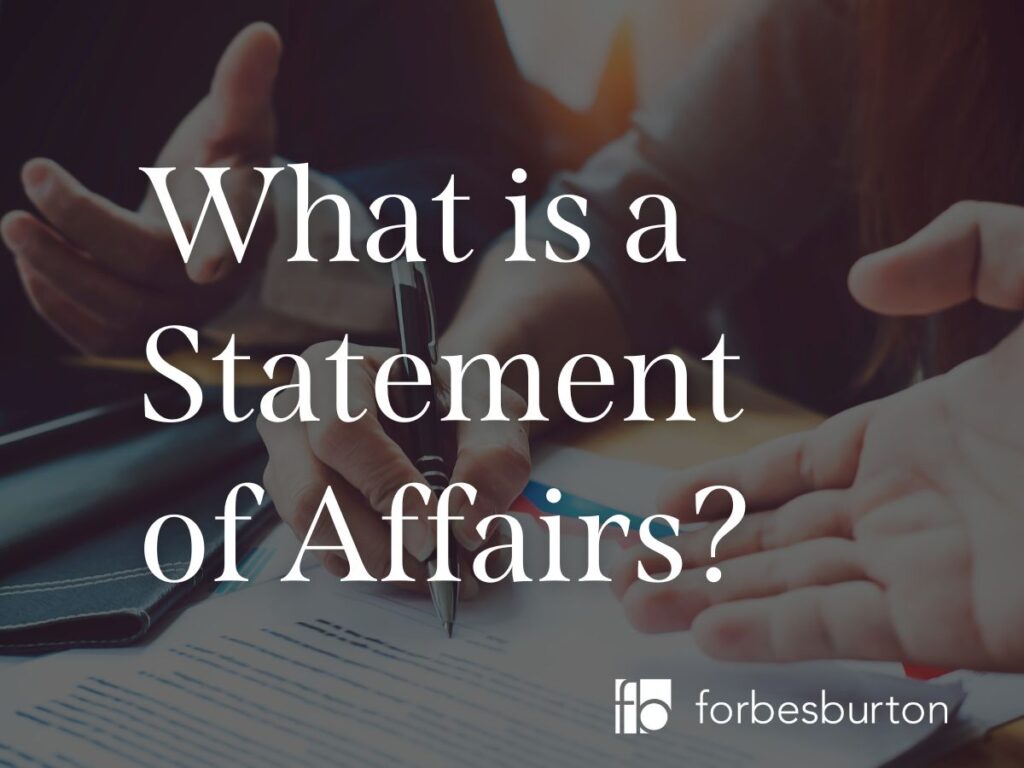
Before any CVL (creditors’ voluntary liquidation) can be executed, a statement of affairs will need to be prepared and verified. But what is a statement of affairs, exactly?
What is a statement of affairs?
A statement of affairs is a record of a company’s financial position at that particular moment. This listing of assets and debts serves as an explanation of how the business is insolvent. Creditors can look at the statement of affairs and see that the business is unable to service their debt properly. It may be that the value of its assets is lower than that of its combined liabilities, meaning that the directors are vindicated in their assertion that their business is insolvent.
This document’s main function is to determine who is owed money by the business and help to identify those who should be given priority in their repayment.
Do I need a statement of affairs?
Not always. A decision will be made by the official receiver on whether one is needed or not. Typically, directors will have to draw up a statement of affairs if their business is either entering administration, voluntary liquidation, compulsory liquidation, or company voluntary arrangements.
Compulsory voluntary arrangements
In a company voluntary agreement, a statement of affairs is central to the proposals given to creditors. The details within it can be used to determine whether they wish to agree to or reject the motion.
Voluntary liquidations
A statement of affairs is required to show the current financial status of the business.
Administrations
Any administrator appointed will request that directors write up a statement of affairs within 14 days of their appointment.
Compulsory liquidations
Here, the statement of affairs is used as a tool to help determine the value of assets that can either be sold or distributed to creditors.
Not sure what to do?
If your company is struggling with unmanageable HMRC debts, poor cash flow, or an uncertain future, you are not alone. We speak to company directors struggling with the same issues as you every single day, and we are here to give you the help and guidance you need.
Call our team for free, no-obligation advice today on 0800 975 0380 or book a free consultation
What is a statement of affairs comprised of?
As part of the creditors’ voluntary liquidation, section 99 of the Insolvency Act 1986, sets out that the following must be included in a statement of affairs.
Asset details
Insolvency practitioners (IPs) have the task of maximising the value of any assets your business may have. They liaise with directors to determine what assets are available to the company, and then research the market value of each item.
Liability details
Liabilities will need to be listed and categorised as secured creditors, preferential and secondary preferential creditors, floating charge creditors, and unsecured creditors before the liquidation process is carried out. The IPs will then work alongside the directors to advise them on which creditors have priority over overs when it comes to being paid back first.
Creditor summary
The statement of affairs needs to include details of any creditors the company has. Names and addresses must be included, alongside the amount that each is owed, and details of any held securities.
Shareholder summary
Like the creditor list, all shareholders must be documented with their names and addresses. The number of shares that each shareholder owns must also be disclosed.
An employee list
This should include addresses, salaries, and start dates
Details on the company’s PAYE and VAT position
Figures should include any late payment penalties that have been accrued.
An up-to-date balance sheet
Any management accounts should be included too.
Will I be fined if my information is inaccurate?
As the statement of affairs is intended to be used as a tool to help directors liquidate their businesses, there’s no benefit to altering the figures. As such there is no requirement to back your figures up with evidence, but the information is expected to be accurate. Creditors will be given the document to amend if they think there are any discrepancies in the figures owed to them.
While no evidence is necessarily needed, the statement of affairs is still a legal document. Any deliberate omissions or misleading information submitted by the director could have serious consequences.
The statement of affairs is usually accompanied by a legal document named a ‘statement of truth’. With this document stating that all the details are correct to the best of your knowledge, any acts of dishonesty can result in a penalty, or disqualification as a director. Liquidators (or insolvency practitioners) are duty bound to compile a director’s conduct report for each case. If any wrongdoing is suspected, owners can be disqualified from being a director, or even found liable for some debts.
What if a director isn’t available to complete a statement of affairs?
In the event that a director isn’t available, the official receiver will pass the responsibility of completing a statement of affairs on to the next most appropriate person. This could be a former officer or anyone who helped to found the company in the year prior. Otherwise, a current or recent employee that’s able to provide sufficient information may be asked instead.
Who writes the statement of affairs?
This depends on the method of dissolution your business has chosen, though directors will need to be involved either way.
An insolvency practitioner will prepare a statement of affairs for any liquidations. They will, however, be depending on the director’s in-depth knowledge of the business to help guide their findings. Once prepared, they then submit the finished statement of affairs to Companies House.
Administrations generally call for directors to write up the statement of affairs instead. It’s classified as a legal document, and as such, failure to submit one within the allotted time frame will incur a hefty fine.
Need some free advice?
Knowing what to do when your business is struggling is difficult, that’s why we offer free, no-obligation advice to explore your options.
Call us today for free, confidential advice on 0800 975 0380 or arrange a free meeting with one of our advisers →
What happens if I don’t complete a statement of affairs?
Directors are generally given a specific period of time in which to submit a statement of affairs to the receiver of the court. Usually this is 14 days from a business entering into administration.
Failing to meet this deadline can be seen as contempt of court and result in a fine of £5,000 or defaulting fines of £500 per day.
Thinking of closing your business?
We’ve helped countless businesses to assess their options when they’ve found economic conditions difficult. By calling for free, no-obligation advice from one of our friendly specialists, you’ll be given all the guidance you need for the best route to take your business.
As business rescue specialists, we can help you to discover the best possible solution to any issues your company might be having. Call us on 0800 975 0380, or email advice@forbesburton.com for a free consultation.

Rick Smith
rick.smith@forbesburton.com
We're here for you.
As a dedicated team of Advisers and Consultants our aim is to help you fix the issues and solve the problems within your business.
Find out more →